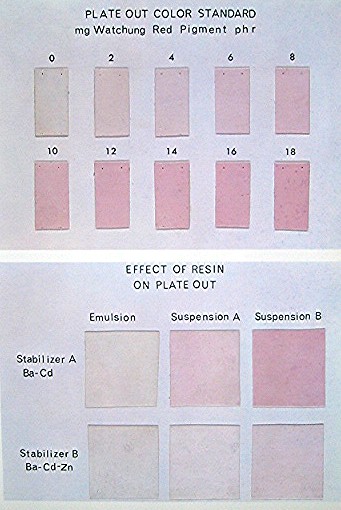One perplexing problem that occasionally arises during long extrusion and calendering runs, especially with opaque, pigmented or filled compounds, is plateout – a term used to describe the buildup or deposit of incompatible material on the screw, in the die, on embossing rolls,roll take-up equipment or sizing sleeves. In time this deposit affects the surface finish of the product, and also provides sites for sticking – leading to degradation. Production down-time for clean-up is then necessary. All the factors responsible for causing plate-out are not fully understood. It is believed that minor incompatibilities of additives are partly responsible but not the whole cause. Changes in type and use levels of lubricants, fillers, pigments and stabilizers, as well as changes in processing conditions (speed, temperature) can affect the severity of plateout – for better or worse. Even the weather (high humidity) has been known to aggravate plateout! Although plateout may occur in a clear formulation, most plateout incidents seem to happen with opaque, pigmented or filled compounds. Invariably, a combination of two classes of metals are usually present in plateout – prone compounds – alkaline earths (calcium, magnesium from the filler or barium from the stabilizer) and heavy metals (most commonly titanium from titanium dioxide pigment, also lead and cadmium from stabilizers or pigments).
Several empirical approaches to the control of plateout have evolved over the years, which have shown varying degrees of effectiveness:
- Stabilizers based on organotin derivatives have not been shown to contribute to plateout, mainly due to their very high compatibility or solubility in the PVC melt. On the other hand, salts of barium, cadmium, calcium, zinc and lead are either insoluble or less compatible with the PVC melt and can aggravate plateout if other conditions are right.
- Compounds based on emulsion polymerized PVC resins (E-PVC) normally cannot be induced to show plateout. In some cases, replacing a small amount (10-20%) of suspension (S-PVC) resin with E-PVC will reduce plate-out. This may be due to the presence of trace amounts of emulsifier present on the resin, for the addition of either cationic or anionic surfactants in very small amounts (0.1 phr) has also been shown to reduce plateout.
- A mechanical approach to plateout control which has worked successfully involves the use of a small amount (0.5 phr) of a silicate filler to contribute mild abrasive or scrubbing action on metal surfaces.
- A small container of mineral spirits mounted above the sizing sleeve of a vacuum cooling tank so as to permit a slow, dropwise addition of mineral spirits on the hot vinyl profile just before entering the vacuum sizer will often keep sizing sleeves clean.
Lab Test for Plateout—
The test compound, containing DuPont’s Wachtung Red pigment(notorious for showing plateout) is processed on a two roll mill, and the sheet discarded, leaving any plateout deposit on the rolls. A high TiO2 containing white “scrubbing” compound with abrasive silicate filler is then processed on the same two roll mill, removed, and the degree of “pink” indicates the degree of plateout in the test compound. The picture shows how PVC resins and stabilizers can affect plateout.







Hello. I have checked your polymeradditives.cn and i
see you’ve got some duplicate content so probably it is the reason that you don’t rank hi in google.
But you can fix this issue fast. There is a tool that creates articles like human, just search in google: miftolo’s tools
I can not visit google, kindly tell me how to do. thanks !